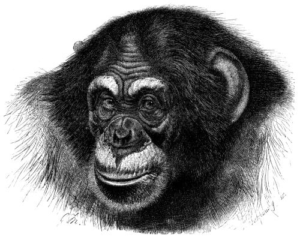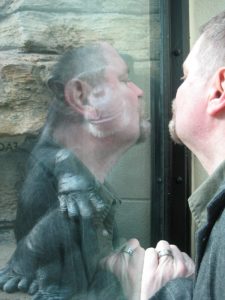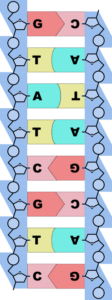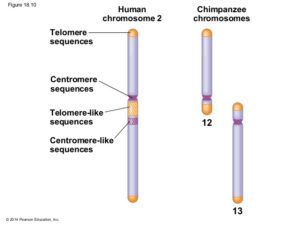
I watched as the African grey parrot intensely studied the proffered tray of objects. Lying upon this salver were several toys. The parrot had been asked to choose the little model automobile from the collection. He did so effortlessly. The particular parrot in question was named Alex. His choosing of the car from the collection was child’s play for him. Alex could comprehend the concept of bigger and smaller. He could identify colors and shapes. He possessed basic number sense, including the ability to add numbers and find their sum. Alex could use dozens upon dozens of words properly. For a non-primate, with a brain the size of a walnut, the intelligence of this animal simply astounded me. Alex died in 2007 at the age of 31 years. Thus his owner, Irene Pepperberg, could probe no further into his astonishing intelligence. Animal psychologist Pepperberg maintained that Alex, at the time of his death, had the intelligence and emotional level of a human child.
Then there was Koko the gorilla (1971-2018). Over the years, Koko was featured in stories in National Geographic and on PBS television. Thus, you may be aware that she had been taught American Sign Language by animal behaviorist Francine Patterson. Although there were skeptics, Ms. Patterson believed Koko could use over one thousand signs and could understand some two thousand spoken words. Moreover, Patterson’s studies suggest that Koko could construct meaningful sentences using her pool of signs and words. I recall reading about an instance in which Koko tried to fabricate an excuse for a bit of misbehavior in which she had indulged. Does this not indicate an incredibly high level of intelligence? Simply entertaining the concept of right and wrong is remarkable for a non-human animal. Actually developing a narrative to avoid consequences for such mischievousness is a piece of astounding mental gymnastics.
Crows and honey badgers using tools, elephants apparently mourning their dead, octopuses learning complicated behavioral sequences: given the time and the inclination to do so, I suppose one could find even more examples of such intriguing animal behaviors. These accounts should remind us that we have far to go in our attempt to comprehend just how complex and advanced the animal mind may be. My guess is that we have sadly underestimated the depth of intelligence and cognitive abilities of our animal kin.
The most astonishing example of non-human, intelligent behavior I ever witnessed took place many years ago at Zoo Negara in Kuala Lumpur. It was an explicit display of forethought, planning, and the execution of a clever scheme. This behavior involved an exceedingly clever chimpanzee, a species known to scientists as Pan troglodytes.
I must admit that chimpanzees have always made me a bit uneasy. Maybe it is their ability to be so terribly vicious. Watching a troop of these animals moving like some sinister death squad, as they silently and cooperatively stalk a red colobus monkey is chilling. Seeing them subsequently rip their prey to pieces in an orgy of violent feasting is shocking. Reports of attacks by chimps (supposedly “pets”) on humans certainly have not assuaged my anxiety. Given their strength, the amount of damage an enraged chimpanzee can inflict is horrifying. Perhaps this terrible tendency to violence reminds us all too well of our own proclivities for homicide, genocide, and war. Why shouldn’t that make us edgy?
Then again, chimpanzees are said to be our closest living relative within the  animal kingdom. The simple fact that chimpanzees look so much like us could be another factor that induces my disquiet. It must be a feeling that is widely shared by other people. As members of any zoo’s primate exhibit, chimps certainly seem to attract a great deal of attention. Visitor’s stare at them, smile at them, taunt them, and laugh at them. In the end, these human observers seem unable to come to grips with just how one should really feel while standing in the presence of an animal which is so nearly a mirror image of us.
animal kingdom. The simple fact that chimpanzees look so much like us could be another factor that induces my disquiet. It must be a feeling that is widely shared by other people. As members of any zoo’s primate exhibit, chimps certainly seem to attract a great deal of attention. Visitor’s stare at them, smile at them, taunt them, and laugh at them. In the end, these human observers seem unable to come to grips with just how one should really feel while standing in the presence of an animal which is so nearly a mirror image of us.
Perhaps the most unsettling experience of this nature that I have undergone myself occurred one afternoon in the Cincinnati zoo. It was winter, there were few visitors at midafternoon, and I was wondering alone through the disconcertingly darkened primate house. Abruptly I came upon an indoor enclosure housing a group of bonobos (Pan paniscus). Bonobos are sometimes called pygmy chimpanzees. They aren’t really that much smaller than the typical chimp but are more slender in build or gracile as scientists might say. Bonobos often stand, and sometimes move about, on two legs.
As I neared their exhibit, a group of bonobos was standing in just such a manner. Upon seeing them, a sudden feeling of disorientation struck me. Standing there in the dim corridor, out of sight or sound of other people, I had the eerie feeling that I had accidentally walked through some sort of time portal. I suddenly stood in the Pliocene Epoch some three million years ago. On the other side of the glass stood three individuals and they looked very much like my australopithecine ancestors. Such was the powerful suggestion of humanity engendered by these frighteningly anthropoid primates. For a moment I was struck by an ancient, innate urge to seek cover. I feared these alien tribe-members would discover my presence and act instinctively to defend their territory! Such was the seeming reality of my encounter. It was a “shiver down the spine” moment that has stayed with me for many years now.
As a measure of just how like we humans the genus Pan really is, consider that the National Primate Research Center has suggested that chimpanzees be placed in the same taxonomic genus (Homo) as humans. They point out that this change could influence the way chimpanzees are perceived and treated. For example, it might then be considered unethical to keep them in zoos. Be that as it may, what it also suggests is that chimpanzees are indeed very, very closely related to humans. I realize this statement will make many folks extremely uncomfortable. Some will reject it outright of course. But it has been obvious for a long, long time (even to non-scientists) that chimps and humans undeniably have much in common. For example, both species share certain blood types, have similar reproductive cycles, limb anatomy, and bipedal walking. Tool use and complex social behaviors are also hallmarks of both species as well.
 Today, with advances in molecular biology, we today have a powerful tool with which to analyze the degree of relationship between species. Through DNA analysis, the relationship between humans and chimpanzees has been even more completely, precisely, and conclusively verified. Molecular biologists have found that chimpanzees and humans share around 98% of their genomic material. In other words, only 2% of the A’s,
Today, with advances in molecular biology, we today have a powerful tool with which to analyze the degree of relationship between species. Through DNA analysis, the relationship between humans and chimpanzees has been even more completely, precisely, and conclusively verified. Molecular biologists have found that chimpanzees and humans share around 98% of their genomic material. In other words, only 2% of the A’s,  T’s, G’s, and C’s that comprise the genetic code for building a human are not sequentially the same in a chimpanzee. For an extremely powerful piece of evidence of the close relationship of humans and chimps, let’s zero in specifically on the genetics of human chromosome number two.
T’s, G’s, and C’s that comprise the genetic code for building a human are not sequentially the same in a chimpanzee. For an extremely powerful piece of evidence of the close relationship of humans and chimps, let’s zero in specifically on the genetics of human chromosome number two.
In each nucleated cell in our body we have 46 chromosomes; chimpanzees have 48. In both cases, the chromosomes are comprised of molecules of deoxyribonucleic acid (DNA) wound around little protein spheres called histones. The histones help build a skeletal structure for the chromosomes. The DNA, of course, carries the genetic blueprint which allows organisms to grow and develop as well as instructions for cells to carry out their life functions. These DNA directions are passed from parents to offspring by means of which life is perpetuated. At the tips of the chromosomes are regions called telomeres. Telomeres are actually segments of a chromosome in which a series of DNA bases, TAGGG for example, are repeated over and over again hundreds of times. Like the aglets at the tips of a shoelace, telomeres occur only at the ends of chromosomes – normally.
Chromosomes also have a region of DNA known as a centromere near their middle. This structure helps chromosomes separate during cell division.  This process is called mitosis and it allows organisms to physically grow in size and to replace old or damaged tissues such as skin and blood. Another characteristic feature of chromosomes is that, under proper staining techniques, very distinct bands appear on them (called G-bands). You might think of these bands as chromosomal bar codes. These distinctive zones of light and dark coloration help technicians to recognize and assign a number to specific chromosomes.
This process is called mitosis and it allows organisms to physically grow in size and to replace old or damaged tissues such as skin and blood. Another characteristic feature of chromosomes is that, under proper staining techniques, very distinct bands appear on them (called G-bands). You might think of these bands as chromosomal bar codes. These distinctive zones of light and dark coloration help technicians to recognize and assign a number to specific chromosomes.
So how does all this relate to the close relationship of humans and chimpanzees? Well, if we align human chromosome 2 next to chimpanzee chromosomes 2a and 2b, a very interesting pattern emerges. The most obvious thing we see is that, when the two chimp chromosomes are butted end to end, their length and banding patterns match those of human chromosome 2. But something even more striking emerges when these chromosomes are analyzed molecularly. Human chromosome 2 not only has telomeres at its ends; it also has telomeric sequences in its middle. Just as significantly, there are two centromere sequences amid human chromosome 2.
chromosomes 2a and 2b, a very interesting pattern emerges. The most obvious thing we see is that, when the two chimp chromosomes are butted end to end, their length and banding patterns match those of human chromosome 2. But something even more striking emerges when these chromosomes are analyzed molecularly. Human chromosome 2 not only has telomeres at its ends; it also has telomeric sequences in its middle. Just as significantly, there are two centromere sequences amid human chromosome 2.
What this demonstrates is that humans and chimps don’t just share some DNA. After all, we share some DNA with essentially every other living thing on earth. No, what this reveals very clearly is that humans and chimpanzees actually share specific chromosomes. The ancestor of chimpanzees and humans had 48 chromosomes. After the evolutionary divergence of these two species some five million years ago, a so-called chromosome fusion event occurred in the human line. This resulted in a reduction in chromosome number from 48 to 46. It also yielded a pair of chromosomes which have telomeres, and an extra centromere in their middle, where they don’t belong so to speak. Is it any wonder that we humans stand before a chimpanzee exhibit and experience such a variety of impassioned responses? Perhaps it is the sensing of our atavistic connection with these animals which causes our emotions to vacillate like a caroming billiard ball when we confront them. Washing over us we feel simultaneously the sentiments of fascination, fear, revulsion, attraction, and, in the end, a longing to know just what it is they are thinking.
 And make no mistake; they are thinking. A chimpanzee has the intelligence quotient of a young human. The degree of inquisitiveness, inventiveness, and problem solving ability this implies is enormous. And here is where the story circles back to the chimpanzee in the Kuala Lumpur zoo. Modern zoos have done much to improve the psychological lot of captive primates. For decades the manner in which chimpanzees were exhibited in zoos was disgraceful. Perhaps we just didn’t know how intelligent, and human-like, these animals were. Maybe it was simple anthropogenic arrogance on our part.
And make no mistake; they are thinking. A chimpanzee has the intelligence quotient of a young human. The degree of inquisitiveness, inventiveness, and problem solving ability this implies is enormous. And here is where the story circles back to the chimpanzee in the Kuala Lumpur zoo. Modern zoos have done much to improve the psychological lot of captive primates. For decades the manner in which chimpanzees were exhibited in zoos was disgraceful. Perhaps we just didn’t know how intelligent, and human-like, these animals were. Maybe it was simple anthropogenic arrogance on our part.
I recall trips to what were considered the best of zoos and even here it was routine to see chimpanzees housed in tiny, sterile, concrete cubicles. Inside there was nothing to engage the occupants. Steel bars and a bare concrete floor was the lot of a typical zoo chimpanzee. Given their high level of intelligence, it is no wonder that these animals exhibited neurotic behaviors. Chimps were prone to activities such as endless pacing, throwing “objects” at visitors, or simply sitting in fatalistic, apathetic quietness. Then again, maybe I shouldn’t have been surprised by this treatment of chimpanzees. We do the same thing to our fellow man. Humans confined in the solitary units (sometimes euphemistically called Intensive Management Units) of prisons likewise exhibit disturbing signs of abnormal behavior. Self-mutilation, violent aggressive outbursts, assaulting of officers with bodily waste, and even autosarcophagy are known.
Today it is common to see primates housed in large cages with plenty of visual and tactile stimuli to engage them. Food is often placed, not in a simple bowl, but hidden in spots requiring the animals to search and find it. The opportunity for physical exercise is provided by climbing apparatuses. Still, in the case of chimpanzees, we are dealing with incredibly intelligent animals. Sadly, sometimes the frills offered them are not enough to satisfy their need for novelty and engagement. In response, they become exceedingly inventive in their endeavors to avoid boredom. Such was the case of the large male I observed.
This fellow was accommodated in a large, open-air enclosure which was bowl-like in shape. Thus, zoo visitors looked down into his arena from an observation area on its rim. In the center of the chimpanzee’s “habitat” was an elaborate climbing contrivance. It much resembled an oversized version of the metal climbing labyrinth often seen on school playgrounds. The chimp had been given some tree branches still bearing leaves. These he could use as both food and entertainment. Grabbing one of the branches, the chimpanzee began to climb the apparatus in the center of his cage. Arriving at the top, he began a series of the pant-hooting calls chimps typical use for communication over long distances. These were accompanied by some half-hearted leaping up and down and the waving about of his tree branch. Suddenly with a loud scream he leaped, in a posture much like a simian sky-diver, from the top of his climbing tower. Outward he sailed and, as he did so, he tossed the tree branch up in the air toward the observation deck and dropped with a thud to the floor of his cage.
Retrieving his piece of vegetation, the ape now methodically removed several of the branch tips. Now he had what was essentially a long stick about two inches in diameter with some short side branches. Finishing his pruning, he now once again climbed the tower and began his hooting performance, all the while waving his stick about menacingly. Again there was the sudden scream, the leap outward, and the tossing of the stick into the air followed by his plunge back to the bottom of the enclosure. By now his performances, and its’ loud sounds, had drawn a healthy crowd of human observers. The throng appreciatively celebrated the chimp’s performance with ooh’s, aah’s, and applause.
Once more he retrieved the object he had thrown. He sat down and again, quite methodically, began to break off any remaining side branches from the limb. Finishing this procedure, he proceeded to break the limb into smaller pieces about six inches long. One of these he selected and, taking it along, again began the climb to the top of his playground equipment. As you could perhaps predict, the old male then began to repeat his previous performance. There was the loud hooting, rapidly increasing in volume. He jumped up and down with renewed vigor. And, of course, there came the skydiver-like launch out into space and toward the mesmerized human audience. Only this time he had one final trick in his bag. Instead of simply hurling the little projectile he carried into the air in a haphazard manner, he did this.
As he leaped from the top of the tower, the chimp brought the stick down between his knees. Now, as he sailed out into the air, he hurled the stick as one would release a Frisbee. It was a perfect backhand release, complete with the final snap of the wrist, which imparted incredible velocity to his missile. And this time, it wasn’t a random toss. He fired the small piece of sharpened wood directly at the people lining the observation deck railing. With loud shrieks of shock and dismay, the people standing there scrambled for their lives as the wooden rocket careened over their heads. A couple of less nimble observers tripped and fell in their haste to avoid being impaled by the incoming missile.
All in all, it was a spectacle of utter chaos. There is no uncertainty in my mind that the big chimp had planned this complex performance with great forethought. The whole sequence of actions he needed to assemble a crowd, scare them half to death, and reap the benefits of their panic-stricken reaction were quite obvious. In fact I would swear that I detected, just before his furry brow fell out of sight below the railing, the slightest hint of a self-satisfied smirk upon his face.
Image Credits: chimpanzee sketch from Brehms Tierleben @ commons.wikimedia.org chimp/human reflection by Stephanie Clifford @ commons.wikimedia.org DNA double helix by Vcpmartin @ commons.wikimedia.org DNA base pairings by A. Spielhoff @ commons.wikimedia.org G-banded chromosomes courtesy of Applied StemCell, Inc. human-chimp chromosomes courtesty Campbell Biology in Focus caged chimpanzee by Andrzej Barabasz @ commons.wikimedia.org
